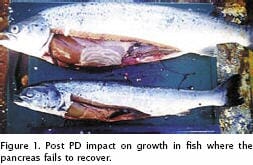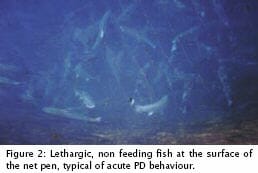

PD is caused by an alphavirus known as salmon pancreas disease virus (SPDV). While there are some molecular differences between isolates from Norway and the Irish and Scottish PD virus, the variation in the manifestation and impact of SPDV infection on individual sites is more related to fish and environmental factors than these viral differences.
In Norway, PD is an important economic disease of Atlantic salmon particularly around the Bergen area. It has also recently been described in sea-reared rainbow trout. It can cause signifi cant losses due to morbidity, mortality, reduced production and downgrading. While the name suggests that the primary organ damaged is the pancreas, severe cardiac and skeletal myopathies are also key features of this disease. One form of chronic PD has also been known as sudden death syndrome (SDS), due to deaths in well conditioned feeding fish.
 Atlantic salmon (Salmo salar L) is considered to be the most susceptible host but published experimental challenges have shown that brown trout (Salmo trutta) and rainbow trout (Oncorhynchus mykiss) are also susceptible; however, the lesion profile is considerably less severe in these latter species. However, in in-house experimental challenge studies, we found that rainbow trout and Atlantic salmon had equally severe lesions www.intervet.no/knowledge/technical-articles.asp. Due to the difficulty of isolating SPDV from natural outbreaks of PD and the widespread distribution of Infectious Pancreatic Necrosis virus (IPNV), which can mask the SPDV and the disease in farmed salmon, PD has been significantly under diagnosed in the fi eld. Other conditions such as cardiomyopathy syndrome (CMS) and heart and skeletal muscle inflammation (HSMI) have also complicated the diagnosis of PD.
Atlantic salmon (Salmo salar L) is considered to be the most susceptible host but published experimental challenges have shown that brown trout (Salmo trutta) and rainbow trout (Oncorhynchus mykiss) are also susceptible; however, the lesion profile is considerably less severe in these latter species. However, in in-house experimental challenge studies, we found that rainbow trout and Atlantic salmon had equally severe lesions www.intervet.no/knowledge/technical-articles.asp. Due to the difficulty of isolating SPDV from natural outbreaks of PD and the widespread distribution of Infectious Pancreatic Necrosis virus (IPNV), which can mask the SPDV and the disease in farmed salmon, PD has been significantly under diagnosed in the fi eld. Other conditions such as cardiomyopathy syndrome (CMS) and heart and skeletal muscle inflammation (HSMI) have also complicated the diagnosis of PD.
All stages of marine-reared Atlantic salmon are susceptible, including S0 and S1 smolts and growers. There is strong evidence of a high level of acquired life-long immunity to PD, as once a population has been infected, new PD outbreaks do not occur. But primary outbreaks of PD can take several months to resolve depending on the age of fish infected and the water temperature.
The pattern and outcome of PD outbreaks has become less predictable with disease occurring during all months of the year and in all sizes of fi sh in Ireland, Scotland and Norway. When PD occurs at winter temperatures, it is very insidious in nature, takes a long time to spread throughout a cage and site, and has a prolonged recovery phase. From a production point of view, winter PD is potentially much more damaging than a PD outbreak shortly after transfer, as, while mortalities may be less, there is a significant loss of growth over a prolonged period.
 An epidemiological survey undertaken in Ireland on 2002-2003 farmed salmon stocks revealed that 15 of 21 sites (71%) had experienced PD with mortality reaching 40% in some cages. The prevalence and severity of PD outbreaks in Norway have steadily increased since the mid 1990s where, in severe cases (e.g., 97 G S0 with 9 % and S0 98G with 20% losses), considerable losses were recorded. Transmission appears to be primarily due to direct fi sh to fi sh contact, but the involvement of other marine reservoirs, such as molluscs, crustaceans and wild fish, or vectors such as sea lice and even vertical transmission, cannot be ruled out.
An epidemiological survey undertaken in Ireland on 2002-2003 farmed salmon stocks revealed that 15 of 21 sites (71%) had experienced PD with mortality reaching 40% in some cages. The prevalence and severity of PD outbreaks in Norway have steadily increased since the mid 1990s where, in severe cases (e.g., 97 G S0 with 9 % and S0 98G with 20% losses), considerable losses were recorded. Transmission appears to be primarily due to direct fi sh to fi sh contact, but the involvement of other marine reservoirs, such as molluscs, crustaceans and wild fish, or vectors such as sea lice and even vertical transmission, cannot be ruled out.
The clinical signs of acute infection with SPDV can be difficult to detect, especially in winter conditions. Classically there is a sudden drop in feed intake, in some cases preceded by voracious feeding. A variable proportion of fi sh become lethargic and can be seen swimming around the edges and corners of the net pen. Some moribund fi sh may be seen hanging from the sides of the nets by their jaws. There may be a small increase in mortalities at this viraemic stage, but the most signifi cant mortalities usually occur 3-6 weeks after the acute phase disease at temperatures of 12-14°C or there may be a more prolonged chronic mortality phase.
An increase in white to yellow cast-like faeces is often associated with PD and these are frequently observed on nets. Other clinical manifestations include sudden death in large fish, which have feed in their gastrointestinal tract, fi sh lying motionless on the bottom of the pen, unusual swimming behaviour (including circling and spiral swimming) and spitting out feed pellets. A variable percentage of fi sh become runts. Sub-clinical infections where the population is infected with SPDV but with no evidence of clinical or signifi cant histological lesions may also occur.
In post-mortem examination of acute phase PD fish, which is rarely detected, there will be no food in the gut, white or yellow casts in the gut
and, occasionally, petechial haemorrhages over the surface of the pyloric caecae. In chronic phase PD, there will be a significant lack of abdominal body fat and poor condition factors in severely affected fish. Large good-conditioned fish with feed in their gut may show no gross lesions but rupture of the heart is occasionally observed (SDS). Histological, serological, and virological examination can confirm the diagnosis (see Agenda No. 6).
Source: Intervet - April 2006
